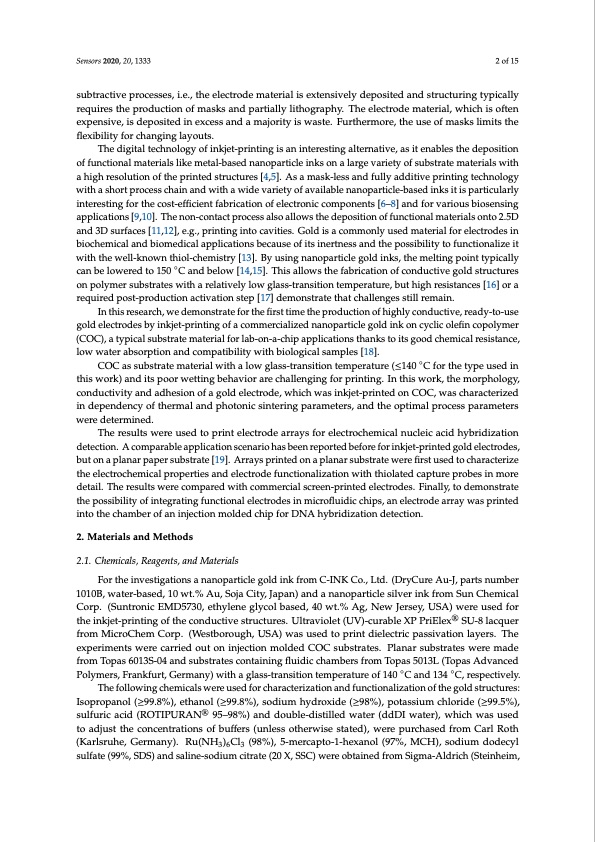
PDF Publication Title:
Text from PDF Page: 002
Sensors 2020, 20, 1333 2 of 15 subtractive processes, i.e., the electrode material is extensively deposited and structuring typically requires the production of masks and partially lithography. The electrode material, which is often expensive, is deposited in excess and a majority is waste. Furthermore, the use of masks limits the flexibility for changing layouts. The digital technology of inkjet-printing is an interesting alternative, as it enables the deposition of functional materials like metal-based nanoparticle inks on a large variety of substrate materials with a high resolution of the printed structures [4,5]. As a mask-less and fully additive printing technology with a short process chain and with a wide variety of available nanoparticle-based inks it is particularly interesting for the cost-efficient fabrication of electronic components [6–8] and for various biosensing applications [9,10]. The non-contact process also allows the deposition of functional materials onto 2.5D and 3D surfaces [11,12], e.g., printing into cavities. Gold is a commonly used material for electrodes in biochemical and biomedical applications because of its inertness and the possibility to functionalize it with the well-known thiol-chemistry [13]. By using nanoparticle gold inks, the melting point typically can be lowered to 150 ◦C and below [14,15]. This allows the fabrication of conductive gold structures on polymer substrates with a relatively low glass-transition temperature, but high resistances [16] or a required post-production activation step [17] demonstrate that challenges still remain. In this research, we demonstrate for the first time the production of highly conductive, ready-to-use gold electrodes by inkjet-printing of a commercialized nanoparticle gold ink on cyclic olefin copolymer (COC), a typical substrate material for lab-on-a-chip applications thanks to its good chemical resistance, low water absorption and compatibility with biological samples [18]. COC as substrate material with a low glass-transition temperature (≤140 ◦C for the type used in this work) and its poor wetting behavior are challenging for printing. In this work, the morphology, conductivity and adhesion of a gold electrode, which was inkjet-printed on COC, was characterized in dependency of thermal and photonic sintering parameters, and the optimal process parameters were determined. The results were used to print electrode arrays for electrochemical nucleic acid hybridization detection. A comparable application scenario has been reported before for inkjet-printed gold electrodes, but on a planar paper substrate [19]. Arrays printed on a planar substrate were first used to characterize the electrochemical properties and electrode functionalization with thiolated capture probes in more detail. The results were compared with commercial screen-printed electrodes. Finally, to demonstrate the possibility of integrating functional electrodes in microfluidic chips, an electrode array was printed into the chamber of an injection molded chip for DNA hybridization detection. 2. Materials and Methods 2.1. Chemicals, Reagents, and Materials For the investigations a nanoparticle gold ink from C-INK Co., Ltd. (DryCure Au-J, parts number 1010B, water-based, 10 wt.% Au, Soja City, Japan) and a nanoparticle silver ink from Sun Chemical Corp. (Suntronic EMD5730, ethylene glycol based, 40 wt.% Ag, New Jersey, USA) were used for the inkjet-printing of the conductive structures. Ultraviolet (UV)-curable XP PriElex® SU-8 lacquer from MicroChem Corp. (Westborough, USA) was used to print dielectric passivation layers. The experiments were carried out on injection molded COC substrates. Planar substrates were made from Topas 6013S-04 and substrates containing fluidic chambers from Topas 5013L (Topas Advanced Polymers, Frankfurt, Germany) with a glass-transition temperature of 140 ◦C and 134 ◦C, respectively. The following chemicals were used for characterization and functionalization of the gold structures: Isopropanol (≥99.8%), ethanol (≥99.8%), sodium hydroxide (≥98%), potassium chloride (≥99.5%), sulfuric acid (ROTIPURAN® 95–98%) and double-distilled water (ddDI water), which was used to adjust the concentrations of buffers (unless otherwise stated), were purchased from Carl Roth (Karlsruhe, Germany). Ru(NH3)6Cl3 (98%), 5-mercapto-1-hexanol (97%, MCH), sodium dodecyl sulfate (99%, SDS) and saline-sodium citrate (20 X, SSC) were obtained from Sigma-Aldrich (Steinheim,PDF Image | Inkjet-Printing Nanoparticle Gold Silver Ink Cyclic Olefin

PDF Search Title:
Inkjet-Printing Nanoparticle Gold Silver Ink Cyclic OlefinOriginal File Name Searched:
sensors-20-01333-v2.pdfDIY PDF Search: Google It | Yahoo | Bing
Turbine and System Plans CAD CAM: Special for this month, any plans are $10,000 for complete Cad/Cam blueprints. License is for one build. Try before you buy a production license. More Info
Waste Heat Power Technology: Organic Rankine Cycle uses waste heat to make electricity, shaft horsepower and cooling. More Info
All Turbine and System Products: Infinity Turbine ORD systems, turbine generator sets, build plans and more to use your waste heat from 30C to 100C. More Info
CO2 Phase Change Demonstrator: CO2 goes supercritical at 30 C. This is a experimental platform which you can use to demonstrate phase change with low heat. Includes integration area for small CO2 turbine, static generator, and more. This can also be used for a GTL Gas to Liquids experimental platform. More Info
Introducing the Infinity Turbine Products Infinity Turbine develops and builds systems for making power from waste heat. It also is working on innovative strategies for storing, making, and deploying energy. More Info
Need Strategy? Use our Consulting and analyst services Infinity Turbine LLC is pleased to announce its consulting and analyst services. We have worked in the renewable energy industry as a researcher, developing sales and markets, along with may inventions and innovations. More Info
Made in USA with Global Energy Millennial Web Engine These pages were made with the Global Energy Web PDF Engine using Filemaker (Claris) software.
Infinity Turbine Developing Spinning Disc Reactor SDR or Spinning Disc Reactors reduce processing time for liquid production of Silver Nanoparticles.
| CONTACT TEL: 608-238-6001 Email: greg@infinityturbine.com | RSS | AMP |